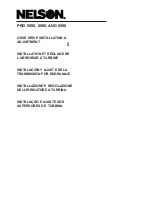
26
RIRS 1200VE EKO 3.0 / RIRS 1200VW EKO 3.0 / RIRS 1200VW EKO 3.0 RHX
www.salda.lt
[ lt ]
[ dk ]
[ en ]
[ de ]
Jutiklių gedimai
Fejl på føler
Sensor faults
Störungen der Fühler
Tiekiamo oro temperatūros jutiklio (TJ) gedimas
Fejl på indblæsning føler(TJ)
Supply air temperature sensor (TJ) fault
Störung des Temperaturfühlers für Zuluft (TJ)
•
[ lt ]
- Išjunkite maitinimo įtampą.
• Atjunkite atitinkamą jutiklio kištuką nuo automatikos.
• Pamatuokite ir patikrinkite jutiklio varžą pagal žemiau pateiktą priklausimybę (pav 1a). Jei gauti
matavimo rezultatai neatitinka nurodytų reikšmių, reikia šį jutiklį pakeisti kitu.
• Po gedimų pašalinimo vėl įjungti ŠVOK agregatui maitinimą.
•
[ dk ]
- Sluk forsyningsspændingen Afbryd den respektive sensor stik fra automatisering. Mål og tjek
sensor spænding ved hjælp af tabel(fig. 1a). Hvis målingen resultaterne ikke svarer til de angivne
værdier, udskifte føleren med den nye. Når fejlen er bliver rettet, tænd anlægget igen.
•
[ en ]
- Switch off the supply voltage
• Disconnect the respective sensor plug from the automation.
• Measure and check the sensor voltage using the bellow dependency (Fig. 1a). If measurement
results do not correspond with the given values, replace the sensor with the new one.
• When faults are corrected, switch on the power supply for the HVAC unit.
•
[ de ]
- Speisespannung abschalten.
• Entsprechenden Fühlerstecker von der Automatik abschalten.
• Widerstand des Fühlers laut folgender Abhängigkeit (Abb. 1a) messen und prüfen. Wenn die
Messergebnisse mit angegebenen Werten nicht übereinstimmen, diesen Fühler durch einen anderen
austauschen.
• Nach Beseitigung der Störungen die Speisung des HKLK-Aggregats wieder einschalten.
Lauko oro temperatūros jutiklio (TL) gedimas
Fejl på friskluft føler(TL)
Outdoor air temperature sensor (TL) fault
Störung des Temperaturfühlers für Außenluft
(TL)
Ištraukiamojo oro iš patalpos (-ų) temperatūros
jutiklio (TA) gedimas
Fejl på udsugning føler(TA)
Extracted room air temperature sensor (TA)
fault
Störung des Temperaturfühlers für die Luft, die
aus dem Raum (Räume) abgezogen wird (TA)
•
[ lt ]
- Išjunkite maitinimo įtampą.
• Atjunkite atitinkamą jutiklio kištuką nuo automatikos.
• Pamatuokite ir patikrinkite jutiklio varžą pagal žemiau pateiktą priklausimybę (pav. 1a). Jei gauti
matavimo rezultatai neatitinka nurodytų reikšmių, reikia grįžtančiojo vandens temperatūros jutiklį
pakeisti kitu.
• Patikinti priešužšaliminio termostatą. Normaliu darbo režimu (kapiliaro aplinkos temperaūra turi būti
aukštesnė negu nustatyta ant termostato) tarp 4 ir 1 gnybtų turi būti uždaras kontaktas (pav. 2a).
• Reikia patikrinti ar tiekiamoji oro temperatūra nėra žemsnė nei nustatyta ant termostato.
• Jei tiekiamo oro temperatūra žema, riekia patikrinti šildyto sistemos mazgus.
•
[ dk ]
- Sluk forsyningsspændingen Afbryd den respektive senso stik fra automatikken • Mål og tjek
sensor spænding ved hjælp skema (fig. 1a). Hvis målingen resultaterne ikke svarer til de angivne
værdier, udskifte føleren med den nye.
• Check frosttermostaten. I normal arbejdspunkt skal udetemperatur være højere end temperaturen på
termostaten. Skal stå på 5°. kontakt skal være lukket mellem terminal 4 og 1.(Fig 2a)
• Check on indblæsningsluften er lavere end termostaten, hvis ja, skal der motorventil, cirkulations-
pumpe, blandesløjfe kontroleres om der kommer varmt vand nok frem til varmefladen.• Når fejlen er
blevet rettet, tændes anlægget igen.
•
[ en ]
- Switch off the supply voltage
• Disconnect the respective sensor plug from the automation.
• Measure and check the sensor voltage using the bellow dependency (Fig. 1a). If measurement
results do not correspond with the given values, replace the return water temperature sensor with the
new one.
• Check the antifreeze thermostat. In normal working mode (the capillary ambient temperature should
be higher than the indicated on the thermostat), contact should be closed between the terminals 4
and 1 (Fig. 2a).
• Check if the supply air temperature is lower than indicated on the thermostat.
• If the supply air temperature is low, check the assemblies of the heating system.
•
[ de ]
- Speisespannung abschalten.
• Entsprechenden Fühlerstecker von der Automatik abschalten.
• Widerstand des Fühlers laut folgender Abhängigkeit (Abb. 1a) messen und prüfen. Wenn die
Messergebnisse mit angegebenen Werten nicht übereinstimmen, diesen Fühler durch einen anderen
austauschen.
• Frostschutzthermostat prüfen. Im Falle einer normalen Betriebsart (kapillare Umgebungstemperatur
muss höher als die auf dem Thermostat eingestellte Temperatur sein) muss zwischen der 4. und der
1. Klemme ein geschlossener Kontakt sein (Abb. 2a).
• Prüfen, ob die Zulufttemperatur nicht die auf dem Thermostat eingestellte Temperatur unterschreitet.
• Falls die Zulufttemperatur niedrig ist, Baugruppen des Heizsystems prüfen.
Grįžtančiojo vandens iš vandeninio šildytuvo
temperatūrinio jutiklio (TV) arba priešužšaliminio
termostato (T1) gedimas.
Fejl på returvands føler(TV) eller fejl på frostter-
mostat føler(T1) skal stå på 5°.
Return water from water heater temperature
sensor (TV) or antifreeze thermostat (T1) fault
Störung des Temperaturfühlers für Rückwasser
aus dem Wasserheizer (TV) oder aus dem
Frostschutzthermostat (T1)
Suveikė priešužšaliminis termostatas (T1)
Frost termostat er aktiveret(T1) skal stå på 5°
Antifreeze thermostat was activated (T1)
Frostschutzthermostat hat angelaufen (T1)
Pav.
1a
Pic.
1a
Pic.
1a
Bild
1a
Temperatūros jutiklių varžos priklausomybė nuo matuojamosios oro temperatūros.
Forskel på modstand af temperatur føler og målt luft temperatur.
Dependency between resistance of temperature sensor and measured air temperature.
Abhängigkeit des Widerstands der Temperatursensoren von der gemessenen Lufttemperatur.
CC - uždaras kontaktas.
CC – Lukket kontaktsæt.
CC – closed contact.
CC – geschlaossener Kontakt.
Pav.
2a
Pic.
2a
Pic.
2a
Bild
2a
Priešužšaliminio termostato patikrinimas.
Inspektion af forst termostat
Inspection of the antifreeze thermostat.
Überprüfung des frostbeständigen Thermostates.
Jutiklio tipas: NTC 10K (10KΩprie 25°C;
ß=3380K)
Type af sensor: NTC 10K (10KΩprie 25°C;
ß=3380K)
Type of sensor: NTC 10K (10KΩprie 25°C;
ß=3380K)
Sensortyp: NTC 10K (10KΩprie 25°C;
ß=3380K)











































